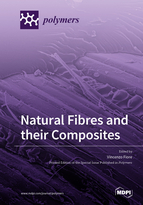Natural Fibres and their Composites
A special issue of Polymers (ISSN 2073-4360). This special issue belongs to the section "Biomacromolecules, Biobased and Biodegradable Polymers".
Deadline for manuscript submissions: closed (31 May 2020) | Viewed by 55846
Special Issue Editor
Interests: natural fibres; polymer composites; biobased materials; hybrid composites; fiber-matrix adhesion; structural joints; mechanical properties
Special Issues, Collections and Topics in MDPI journals
Special Issue Information
Dear Colleagues,
A rising interest in environmentally friendly fibre reinforced composites (i.e., derived from renewable resources) has been recorded over the last decades due to the rising global awareness of environmental issues. In this context, natural fibres from different biorenewable resources (i.e., vegetal, mineral and animal sources) have attracted great attention both from academia and from several industrial fields thanks to their specific properties, low prices, great availability, health advantages, easy processing, renewability, biodegradability and recyclability.
This Special Issue aims to present the developments made in the field of natural fibres and their composites, including but not limited to the following aspects:
- Fibre extraction and retting processes;
- Characterization of fibre properties;
- Fibre treatments;
- Manufacturing processes of composites;
- Characterization of composite properties;
- Evaluation of composite aging resistance.
Authors are invited to submit original research as well as review papers to this Special Issue.
Prof. Dr. Vincenzo Fiore
Guest Editor
Manuscript Submission Information
Manuscripts should be submitted online at www.mdpi.com by registering and logging in to this website. Once you are registered, click here to go to the submission form. Manuscripts can be submitted until the deadline. All submissions that pass pre-check are peer-reviewed. Accepted papers will be published continuously in the journal (as soon as accepted) and will be listed together on the special issue website. Research articles, review articles as well as short communications are invited. For planned papers, a title and short abstract (about 100 words) can be sent to the Editorial Office for announcement on this website.
Submitted manuscripts should not have been published previously, nor be under consideration for publication elsewhere (except conference proceedings papers). All manuscripts are thoroughly refereed through a single-blind peer-review process. A guide for authors and other relevant information for submission of manuscripts is available on the Instructions for Authors page. Polymers is an international peer-reviewed open access semimonthly journal published by MDPI.
Please visit the Instructions for Authors page before submitting a manuscript. The Article Processing Charge (APC) for publication in this open access journal is 2700 CHF (Swiss Francs). Submitted papers should be well formatted and use good English. Authors may use MDPI's English editing service prior to publication or during author revisions.
Keywords
- natural fibres;
- polymer composites;
- bio-based materials;
- hybrid composites;
- fibre–matrix adhesion







